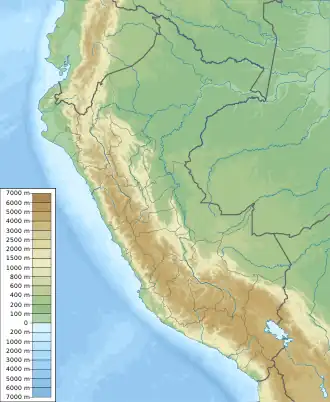Pucaranra
Pucaranra[5][6][7][8] (possibly from Quechua puka red, ranra stony; stony ground,[9][10]) is a mountain in the Cordillera Blanca in the Andes of Peru, about 6,147 metres (20,167 ft) high[5] (although other sources cite an elevation of 6,156 metres (20,197 ft).[6][7][8] It is located in Ancash, southwest of mount Chinchey.[5][6] Its territory is within the Peruvian protection area of Huascarán National Park, at the border of two provinces: Carhuaz and Huaraz (Districts of San Miguel De Aco and Independencia).[11]
| Pucaranra | |
|---|---|
 Palcaraju (on the left) and Pucaranra (on the right) behind Lake Palcacocha | |
| Highest point | |
| Elevation | 6,147 m (20,167 ft) |
| Prominence | 2,903 m (9,524 ft)[1] |
| Parent peak | Chinchey |
| Coordinates | 9°23′30″S 77°21′03″W |
| Geography | |
 Pucaranra Peru | |
| Location | Peru, Ancash Region |
| Parent range | Andes, Cordillera Blanca |
| Climbing | |
| First ascent | 07/04/1948 - B. Lauterburg, Federico Marmillod, R. Schmid and F. Sigrist (Switzerland)[2][3] via S.W. spur of S. ridge
Variant on S.W. side-1954 E. slopes-1957: N.E. ridge-1959 S.W. ridge, S.W. face-1965 W. ridge-1977[4] |
| Easiest route | southeast ridge, AD |
First Ascent
Pucaranra was first climbed by B. Lauterburg, Federico Marmillod, R. Schmid and F. Sigrist (Switzerland) April 07th 1948 via Southwest spur of the south ridge.[2][3]
Elevation
Other data from available digital elevation models: SRTM 6138 metres[12] and TanDEM-X 5961 metres.[13] The height of the nearest key col is 3253 meters, leading to a topographic prominence of 2903 meters.[14] Pucaranra is considered a Mountain Sub-System according to the Dominance System [15] and its dominance is 47.16%. Its parent peak is Chinchey and the Topographic isolation is 2.4 kilometers.[14]
Climbing
Several interesting lines on this mountain, none of them very serious but all requiring commitment. The east-northeast ridge is rated AD/D (depending on conditions), the southeast face AD+ and the southeast ridge AD.[16]
References
- "Pucaranra". Andes Specialists. Retrieved 2020-04-12.
- Ostrowski. Mas Alto que los Condores.
- "AAJ (American Alpine Journal)". AAJ (American Alpine Journal): 113. 1958.
- Jill Neate, Mountaineering in the Andes, 1994
- Díaz, Felipe (2008–2009). Carta Turística. Cordilleras Blanca, Negra, Huayhuash y Callejón de Huaylas.
- Alpenvereinskarte 0/3b. Cordillera Blanca Süd (Peru). 1:100 000. Oesterreichischer Alpenverein. 2005. ISBN 3-937530-05-3.
- Biggar, John (2020). The Andes: A Guide for Climbers and Skiers. Andes. p. 100. ISBN 9780953608768.
- "Nevado Pucaranra - Peakbagger.com". peakbagger.com. Retrieved 2016-06-18.
- Teofilo Laime Ajacopa (2007). Diccionario Bilingüe: Iskay simipi yuyayk’anch: Quechua – Castellano / Castellano – Quechua (PDF). La Paz, Bolivia.
{{cite book}}: CS1 maint: location missing publisher (link) - "Diccionario: Quechua - Español - Quechua, Simi Taqe: Qheswa - Español - Qheswa" (PDF). Diccionario Quechua - Español - Quechua. Gobierno Regional del Cusco, Perú: Academía Mayor de la Lengua Quechua. 2005.
- PERU, Autor: GEO GPS. "Base de datos Perú - Shapefile - *.shp - MINAM - IGN - Límites Políticos". Retrieved 2020-04-30.
- NASA, Jet Propulsion Laboratory. "Shuttle Radar Topographic Mission - Filled Data V2". Retrieved 12 April 2020.
- TanDEM-X, TerraSAR-X. "Copernicus Space Component Data Access". Retrieved 12 April 2020.
- "Pucaranra". Andes Specialists. Retrieved 2020-04-12.
- "Dominance - Page 2". www.8000ers.com. Retrieved 2020-04-12.
- "AAC Publications - South America, Peru, Pucahirca Central and Pucaranra, Cordillera Blanca". publications.americanalpineclub.org. Retrieved 2021-08-17.